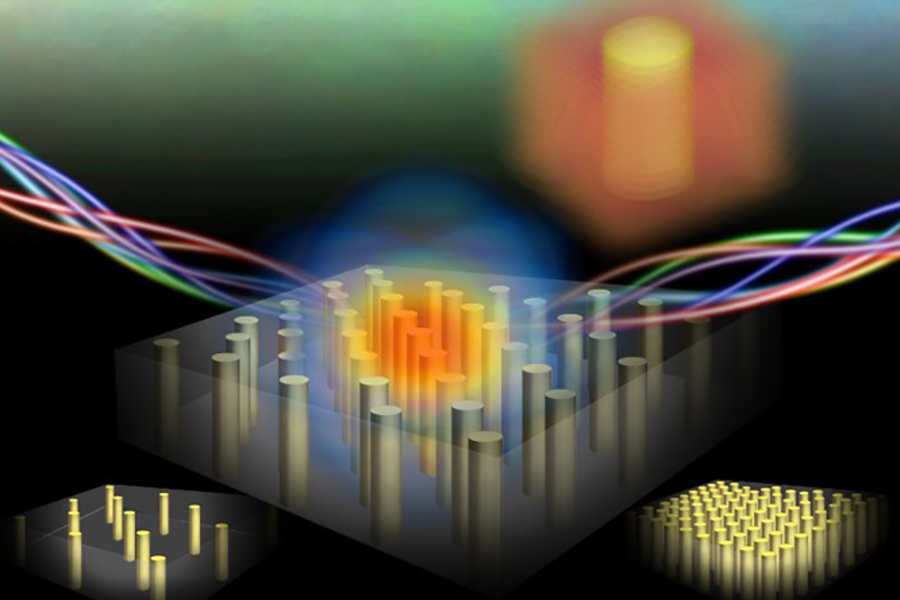NSF-funded research advancing photon-based circuits means a brighter future for information processing

A team of researchers from Purdue University’s College of Engineering has received a Designing Materials to Revolutionize and Engineer our Future (DMREF) award from the National Science Foundation (NSF) to develop new hybrid materials for universal, large-scale photonic integrated circuits (PICs). Haiyan Wang, Basil S. Turner Professor of Engineering, is the PI on the project, which has implications for improved information processing. In addition to Wang, team members include Peter Bermel, Elmore Professor of Electrical and Computer Engineering (ECE), Minghao Qi, Professor of ECE, and Edwin Garcia, Professor of Materials Engineering.
Transmitting and processing information traditionally involves electronic circuits, which use electrons to do the job. The research in this project uses photons. These photons have some properties that make them ideal for handling information. They can move fast and carry a lot of data. However, there are still some challenges to overcome when using light for these circuits, like directing the light where we want it to go, keeping it separate from other light, and switching it on and off when needed.

One of the materials used for making electronic circuits is silicon, which is inexpensive and can be mass-produced in large quantities. When it comes to PICs, however, there is a need to use different materials on top of silicon, which is not easy. The DMREF award supports research to create new materials that will serve as the building blocks for the PICs of the future. These materials will have special properties that can be customized for controlled light-matter interactions and will work well together. These materials can be directly deposited and integrated on chips, unlike the current hybrid materials prepared by lithography and patterning methods.
“The team members are excited for this new collaborative research opportunity,” said Wang. “We have been working collaboratively in a bilateral fashion for several years. The NSF DMREF project made this concerted effort on new materials discovery possible.”
These advances will be an improvement in areas such as telecommunications, healthcare, and sensing. The research findings will be incorporated into student research training at both graduate and undergraduate levels and education modules for a co-developed course and summer research programs for undergraduates and high school students.
About Purdue University
Purdue University is a public research institution with excellence at scale. Ranked among top 10 public universities and with two colleges in the top 4 in the United States, Purdue discovers and disseminates knowledge with a quality and at a scale second to none. More than 105,000 students study at Purdue across modalities and locations, with 50,000 in person on the West Lafayette campus. Committed to affordability and accessibility, Purdue’s main campus has frozen tuition 12 years in a row. See how Purdue never stops in the persistent pursuit of the next giant leap, including its first comprehensive urban campus in Indianapolis, the new Mitchell E. Daniels, Jr. School of Business, and Purdue Computes, at https://www.purdue.edu/president/strategic-initiatives.
About the Elmore Family School of Electrical and Computer Engineering
The Elmore Family School of Electrical and Computer Engineering is the largest academic unit at Purdue University and the largest ECE department in the country. Established in 1888, the school offers both undergraduate B.S. degrees in either Electrical Engineering or Computer Engineering as well as M.S. and Ph.D. graduate degrees in Electrical and Computer Engineering. The school enrolls more than 2,000 undergraduates (sophomores through seniors) and nearly 1,500 graduate students. Degree programs on the West Lafayette campus are consistently ranked in the top 10 by the U.S. News & World Report. U.S. News also ranks the online master’s program in electrical engineering No. 1 in the nation. Purdue ECE aims to serve and lead the state of Indiana, the nation, and the world-wide profession of electrical and computer engineering by educating the next generation of engineers, by discovery that advances fundamental knowledge and its applications, and by innovation and engagement that address global challenges of societal impact.
About the School of Materials Engineering
Established in 1959, the School of Materials Engineering (MSE) is known for its hands-on, authentic, educational approach and providing an excellent learning environment while carrying out cutting-edge research that impacts the state, nation, and world. The School prepares students to excel in applications and innovations for metals, polymers, ceramics and electronic materials, and a degree in MSE means graduates are qualified and sought after to work in almost any industry. Ranked in the top 15 MSE programs by U.S. News and World Report, the School is one of the five largest programs in the country with over 200 undergraduate students and more than 170 graduate students advised by a team of more than 30 faculty.
